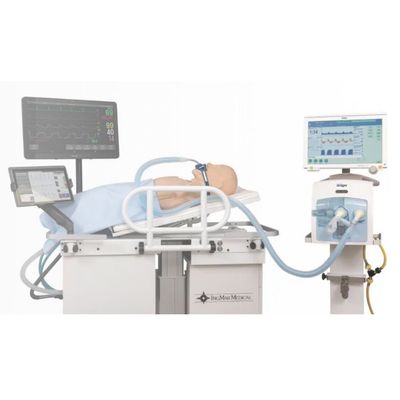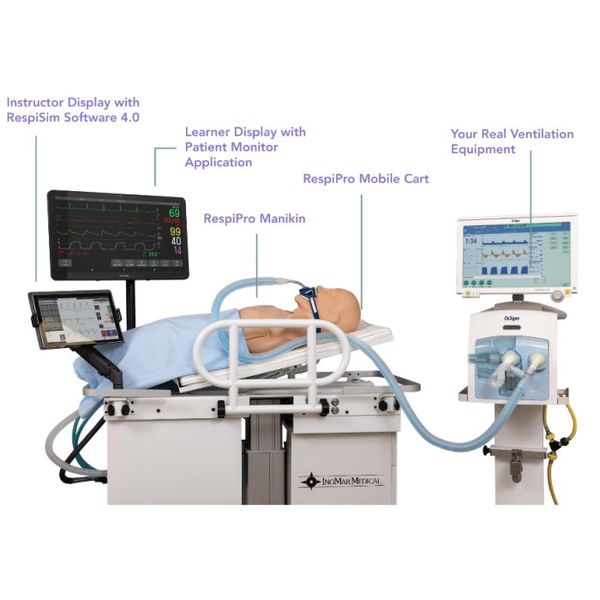

- Home
- Companies
- IngMar Medical
- Products
- RespiPro - Model RespiSim - Respiratory ...

RespiPro - Model RespiSim - Respiratory Simulation System
Introducing the NEW RespiPro — an all-in-one respiratory simulation solution for providing high-fidelity, effective simulation experiences.
The RespiSim® System is designed to provide comprehensive simulation training built around the world’s most realistic breathing simulator, the ASL 5000™. Use the RespiSim System to conduct high-fidelity respiratory and ventilation training using your own real ventilators and respiratory devices.

- Provoke realistic interactions between the simulated patient’s respiratory mechanics and the full scope of real ventilation devices
- Enhance the perception of realism with manikin chest movement and expansion consistent with the simulated patient’s breaths
- Practice information gathering using the simulated stethoscope for auscultation and the true-to-life patient monitor for the patient’s physiological information
- Increase psychomotor abilities including CPR, intubation, needle decompression, chest tube insertion and more
- Utilize the realism and flexibility of the mini ICU bed with collapsible bed rails and adjustable bed height and angle
- Facilitate systematic yet flexible simulation experiences with the easy-to-use software, designed by educators, for educators
- Create and customize scenarios without restriction using the widest range of respiratory parameters, over 90 lung models neonatal through adult, and a library of waveforms, images, and sounds
- Accommodate an unlimited number of patient outcomes with ease by activating lung model parameters and patient physiology simultaneously during the simulation
- Spend less time controlling the software by automating scenario progression with triggers including the amount of time elapsed and the completion of learner actions
- Enrich learning with debrief and feedback sessions using the playback of timestamped learner actions and instructor notes as well as waveform, breath parameter and ventilator data
- Enhance curriculum, provide opportunities for standardized clinical experiences, address competencies, improve quality of care and patient safety, and promote readiness for clinical practice with the all-in-one respiratory simulation solution
- Support transport scenarios with the option for tetherless mobile cart capability
- Move through the full scope of patient care from initial CPR maneuvers to bag-valve-mask ventilation and intubation, all the way to complex ventilator management skills and weaning
- High-fidelity active servo lung designed specifically for ventilator management training; its innovative design allows you to simulate virtually any respiratory scenario, including a patient whose condition changes over time.
- Resistance 3 to 350 cmH2O/L/s
- Compliance 0.5 to 250 mL/cmH2O
- Ventilator-grade spontaneous breathing passive to 100 bpm
- Patient effort (muscle pressure) 0 to 50 cmH2O
- Tidal Volume 2.1 L
- Holds PEEP at any clinically relevant level including 0 to > 20 cmH2O
- Spontaneous breathing recognized by real mechanical ventilators
- Control patient’s work of breathing with variable patient effort
- Interacts realistically with most modes of ventilation including Pressure/Volume Control, HFOV, and particularly spontaneous modes such as Pressure Support, ASV, and PAV
- Ability to simulate neonatal and pediatric breathing patterns
- Able to interact with High Frequency Oscillatory Ventilation (HFOV)
- Interacts with Bag-valve Mask (BVM) and Non-invasive Ventilation (NIV)
- Vary lung parameters individually during scenario with immediate impact on ventilator waveforms
- Change between volume and pressure control modes seamlessly on the same patient without re-adjusting lung parameters
- Simulate spontaneous breathing trial scenarios
- Simulate any type of patient-ventilator dysynchrony scenario (inspiratory, expiratory, trigger, and cycle)
- Save custom lung models which can be activated immediately during scenario
- Simulate tracheal as well as left and right bronchi branch resistances
- Simulate independent inspiratory and expiratory resistances
- Simulate independent left and right lung compliances
- Real-time waveform data displayed for instructor (such as flows, pressures, volumes, PIP, PEEP, Pplat, Rate, Tidal Volume)
- Simulate neonatal through adult patients (manikin integration for adult patients only)
- Compatible with RespiPro™ manikin
RespiPro™ Manikin is a specialized respiratory manikin with an anatomically-correct airway and chest structure paired with high fidelity spontaneously breathing lungs, the ASL 5000. RespiPro Manikin’s compact torso is easy to transport and to store. It is ideal for training in:
Airway Management:
- Head tilt, jaw thrust, chin lift
- Anatomically accurate oral and naso pharyngeal airway
- Larynx piece with palpable rings for both surgical and needle cricothyroidotomy and percutaneous tracheostomy
- Full use of supraglottic devices
- Endo-tracheal tube insertion with direct laryngoscopy
- Effective bag mask ventilation
- Combi tube insertion
- Naso gastric tube insertion techniques
- Realistic chest movement and expansion consistent with patient’s breaths including volume, depth and rate
Chest tube insertion: recognition of correct position, surgical incision, blunt dissection through chest wall, perforation of pleura, and finger sweep:
- Anatomically accurate chest tube insertion in the 5th intercostal space
- Realistic feel of all thoracic palpable landmarks
- Cavity for introduction of optional liquids for simulation of hemothorax or pleural effusion
Needle Decompression of tension pneumothorax:
- Option to introduce air to create either right or left tension pneumothorax
- Needle decompression replacement tissue sets located in 2nd intercostal space at mid-clavicular line
- Successful needle insertion releases air with the familiar “hiss” sound
- Durable replacement tissue facilitates up to 30+ needle incisions
Identification of tracheal deviation and jugular vein distension:
- Jugular vein distension can be observed on either the left or right side of the neck during tension pneumothorax
- Tracheal deviation can be palpated and clearly visible moving away from the side that has tension pneumothorax
- Both features revert back to neutral upon successful needle decompression
Cardiopulmonary Resuscitation (CPR):
- Realistic chest structure allows for easy identification of all anatomical landmarks
- Full head tilt, chin lift, and jaw thrust capabilities to allow the students to prepare the airway prior to resuscitation
- Lifelike recoil during compressions
- Successful ventilation will provide an accurate representation of chest rise and fall
RespiSim Software allows instructors to stay in control of the simulation. You can amplify effects, throw students a curveball, or get the simulation back on track to ensure that learning goals are met.
- 90+ lung models, neonatal through adult
- Randomize all lung parameters within a set boundary
- Set a trend for each lung parameter individually
- Set patient’s inspiratory time (Ti) directly
- Simulate a cough breath during simulation with one click
- All lung model parameters and patient physiology can be saved together and activated simultaneously during a simulation
- Progression of scenario can be built to accommodate an unlimited number of paths for the learner and multiple outcomes (positive and negative)
- Scenario can progress automatically from one Patient Condition to the next based on triggers such as time-elapsed or learner actions
- Scenario Worksheet allows users to enter scenario details such as equipment list, learning objectives, patient information, etc. directly within the software
- Playback all waveform and breath parameter data resulting from a completed simulation
- Data from simulation can be exported and viewed on other PCs with RespiSim Software
- Real data extracted from ventilator can be reviewed during the live simulation and in the debrief with the Ventilator Interface Kit Option; includes mode, set parameters and alarm settings
- User is automatically prompted to perform software updates through the software
Learner Display with Patient Monitor Application
- Library of ECG, BP, SpO2 and ETCO2 waveforms able to be displayed
- Heart Rate
- Blood Pressure
- Respiratory Rate
- Oxygen Saturation
- End-tidal CO2
- Chest x-rays
- Ultrasounds
- CT Scans
- ECGs
- Lab results
